Blog
Sunday, September 2nd, 2012
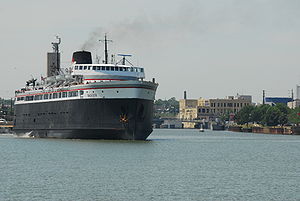
For anyone who has used the car-ferry between Luddington, MI and Manitowac, WI there are numerous benefits to the trip. The trip, by ferry, is 4 hours. By car it is 7.5 hours (not including stops). Travel by ferry has a nostalgic aspect to it. You get out of the car, walk around, get something to eat, gaze out at the beauty of Lake Michigan. There is a snack bar, a dinning room, video arcade and children’s playroom. When the weather is good, you can sun on a lounge chair on the deck. It sounds idyllic, so what can be bad.
Usually, any form of mass transit is better environmentally than using your own car. This is not the case with the S.S. Badger. The Badger is the last coal fired ship on the Great Lakes. It dumps 4 tons of coal ash per day into Lake Michigan. According to environmental groups, the ashes contain lead, mercury and arsenic and potentially could contaminate the drinking water supply of over 10 million people.
In 2008 the E.P.A. gave them 4 years to comply with the Clean water Act. Now the owners of the S.S. Badger filed for a 5 year extension of their permit to dump coal ash in Lake Michigan. They are basing their request on the complexities of conversion to liquefied natural gas at a cost of over $8 million, even though LNG is not readily available in the Michigan market.
The owners of the S.S. Badger have tried other tricks to prevent them from having to spend money to convert to a cleaner fuel. They tried having the ship declared a National Landmark and have pressed legislators in Congress from both Wisconsin and Michigan to grant it an exemption to the Clean Water Act rules.
As reported at MLive.com Alliance for the Great Lakes President Joel Brammeier thinks he has a simple solution to the Badger problems that will end the historic 50-year-plus coal ash discharges into the lake and keep the Badger operating and providing an economic boost to both states.
Instead of granting the Badger the five-year permit while Lake Michigan Carferry owners explore converting the 410-foot ferry from coal to liquefied natural gas, Brammeier made two suggestions.
• Convert the coal-powered steam ship – the only remaining one in the United States – to diesel engines.
• Develop a means to store the hot coal ash in the Badger’s hull to be offloaded and disposed after the ferry arrives in port.
Both these suggestions make more sense to me then trying a complex conversion to LNG. Diesel conversion has been done by other ship owners in as little as 6 months. Conversion to diesel could be completed in the off-season and be ready for next summer. The EPA does not need to grant a 5 year extension to keep the $40,000,000 impact to the port communities and the jobs this makes possible. Instead they should deny the permit and demand either a conversion to diesel or the storage of the ash on board until it can be safely offloaded at port for proper treatment.
Tags: Ash, Clean Water Act, Coal, Diesel, Great Lakes, Lake Michigan, Pollution, S.S. Badger
Posted in Blog, Latest News | No Comments »
Saturday, September 1st, 2012
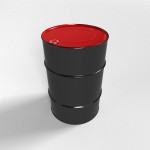
A recent article by Tom Vanderbilt in Slate called the wooden pallet “the single most important object in the global economy. He claimed that 80% of U.S commerce is carried on pallets and that wood pallets account for over 46% of U.S. hardwood production.
While the average U. S. consumer may only know wood pallets from their local Sam’s Club, COSTCO, or garden center, as a distributor of industrial packaging, we at Maxi Container, Inc. know just how important are wood pallets. Almost all of our LTL shipments travel on wood pallets. We use wood pallets in our warehouse to help us properly stack the over 20,000 steel, plastic and fiber drums that we keep in stock. We also used old pallets to make our rain barrel stands that we sell at Green Fairs and through our mirainbarrel line of business.
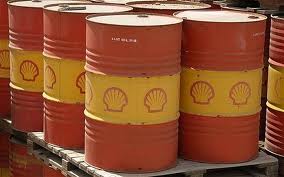
However, after 20+ years in the industrial packaging business, I want to nominate another under recognized and often overlooked Unsung Hero of Global Commerce, the 55 gallon drum. According to industry statistics over 24 million steel drums were reconditioned in the U.S. in 2011. In addition as of 2009 another 21 million new steel drums were manufactured in the U.S. As large as these numbers are, they do not include, Europe or Asia (including the emerging markets of China and India) were millions more steel drums are made and reconditioned.
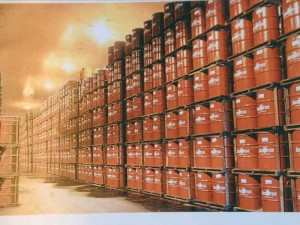
Acids, adhesives, fuels, foods, hazardous and nonhazardous waste, oils and lubricants, paints and coatings, pesticides, pharmaceuticals and solvents are just some of the many items that are routinely shipped in 55 gallon steel drums. They myriad items shipped in steel drums continues to amaze me. Almost every product I see and use, at some point, was in a steel drum. Apple, orange and other fruit juices, Vanilla Extract, motor oil, gasoline, paint, adhesives, Window Cleaner and cleaners of all types, fragrances, soybean oil, chemicals to numerous to mention, used batteries and ballasts, soap and peanut butter to just name a few. As the pictures show, for every wood pallet, there are 4 steel drums. As I often say, without the 55 gallon steel drum industrialized society would grind to a halt.
Tags: 55 gallon, Barrels, Drums, Industrial Packaging, Steel Drums
Posted in Blog, Latest News | No Comments »
Thursday, August 9th, 2012
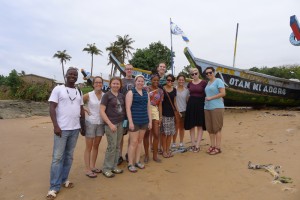
Back in March we donated a steel drum to the University of Michigan School of Art and Design. Ten students and their instructor were going to visit Ghana this summer to help local villagers make charcoal in a more sustainable manner. They promised to keep in touch and they did. I received an email from U of M School of Art and Design Detroit Connections Coordinator Charlie Michaels recently giving me a link to their blog.
The students are spending 3 weeks in Ghana this August. They are staying and working in Nungua, a village outside of Accra, with a local NGO called Cross Cultural Collaborative – Aba House as it is known in locally. From following the blog they are not only making sustainable charcoal from corn cobs. They are learning to make paper out of sugar cane, watch local artisans make beads from found plastic articles and to play the local games with the areas children.
From looking at the blog, this seems to be an adventure of a lifetime for these students. Maxi is proud to have assisted them and we look forward to following their blog. GO BLUE! – even in Ghana.
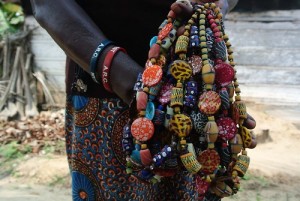
Making Beads From Discarded Plastic
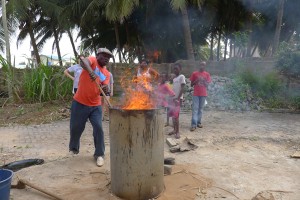
Making Charcoal in Ghana
Tags: charcoal, Ghana, Michigan, U of M, University of Michigan
Posted in Blog, Latest News | No Comments »
Wednesday, August 8th, 2012
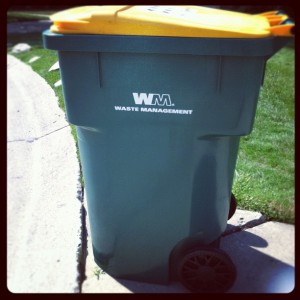
Recently, the recycling authority serving my hometown of Farmington Hills, MI, the RRRASOC – the Resource, Recovery and Recycling Authority of Southwest Oakland County, went to single stream recycling. Single stream recycling is a system in which all recyclables, including newspaper, cardboard, plastic, aluminum, junk mail, etc., are placed in a single bin or cart for recycling. These recyclables are collected by a single truck and taken to a Materials Recovery Facility (MRF) to be sorted into various commodity streams for sale to markets, where it is processed into feedstock which can be used in the manufacture of new products. Here is a picture of our new 96 gallon cart, which is 82 gallons larger than our old bin.
Until recently, the predominant form of curbside recycling in the U.S was “dual stream” collection where each material type is kept in a separate bag or bin, and trucks have three or more compartments. The move to single stream recycling is a way to reduce costs. On the collection side, the use of a large roll-cart allows collectors to automate pick-up from inside the truck cab, and single-compartment trucks save labor and transportation costs. (See, Single Stream Uncovered by Clarissa Morawski, Resource Recycling, Feb. 2010). Due to the ease of use and larger bin sizes, cities often see an increase in recycling rates. In areas where single stream recycling is offered, participation is around 95%. Ann Arbor, MI had a 20% increase in recycling tonnage after implementing single stream recycling in 2010. Unfortunately, that 20% increase was 40% short of projections and caused Recycle Ann Arbor to request an increase of over $107,000. Ann Arbor’s single stream recycling system cost over $4.6 million to implement and, based on the overly optimistic projections, was expected to take 7 years to repay the costs.
The real complaint against single stream recycling is an increase in contaminants, causing a decrease in value for the recycled materials and an increase in the amount of previously recycled materials going to landfills. The Blue Heron Paper Company saw the level of contamination go from 3.3% in 1999 to 6.1% in 2005. This caused them to send over 11,000 tons of material to landfills in 2005, up from 5,200 tons in 1999. However, by implementing a consumer education program and investing in new technology at the material recovery facility, the Metro Waste Facility in central Iowa was able to keep contaminant levels to 3%.
Michel E. Hoffman of Wunderlich Securities points out one of the other possible downsides of single stream recycling. He believes that the move to single-stream recycling could have consequences. Hoffman says, “There are a lot of small- and medium-sized companies that will have to think about building single-stream MRFs. Some won’t have access to capital. Those who do have capital may not want to risk it. The alternative would be to sell to a larger competitor. So as single-stream processing matures, it may fuel a new wave of consolidation in the waste industry.”
The recession of 2008 has led to reduced city budgets. This has only sped the adoption of single stream recycling due to its lower costs. With this pressure on government to reduce costs, despite its mixed success, despite increased contaminants and increased consolidation (leading to less competition) it looks like Single Stream recycling is here to stay.
Tags: Farmington, Farmington Hills, Green, Green LIving, Michigan, Recycling, Recycling Containers, single stream, sustainability
Posted in Blog, Latest News | No Comments »
Wednesday, July 4th, 2012

Last month I spent some time in Alden, MI on the shores of Torch Lake. Unknown to many visitors who are there to swim and boat the beautiful waters of Torch Lake, right in the heart of town is a trail system through a wonderful natural area known as Coy Mountain Natural Area.
The Coy Mountain Natural Area dates back to 1885 when Reuben Coy decided to preserve a ridge forested in virgin hardwoods that towered behind his gristmill. It was the last remnant of the giant maples and beeches in a region that had been heavily clear cut by loggers.
The 11-acre tract remained in the Coy family until 1958 when Reuben’s daughter-in-law deeded the property to a group of trustees with the intentions of preserving Coy Mountain “for the use and benefit of the Villagers of Alden and the surrounding communities”. The trustees presented the land to Helena Township in 1985.
Additional land donations from local residents enlarged the park to it’s current 17 acres. The construction of the trail system was an Eagle Scout project with Alden Volunteers assisting to expand and complete the project and the Alden Lumber Company donating the materials. Other groups, from Michigan Youth Corps to Mancelona Public Schools, have put in their time to help preserve this mountain in the middle of this small Antrim County town.
While the town of Alden is 604 feet above sea level, elevations in the Coy Mountain Natural Area get as high as 775 feet. While the 171 foot climb over the 1.5 mile trail can be challenging at times, it is well worth it. Despite the fact that the last virgin trees in the forest were stolen around 1993, the American Beech, Sugar Maple and Hemlock that make up most of the forest are breathtaking.
While Torch Lake is the main attraction in town, if you are heading to northern, MI and find yourself in Alden, definitely take the time to hike the Coy Mountain Preserve.
[slickr-flickr search=”sets” set=”72157630413519594″ type=”slideshow”]
Tags: Coy Mountain, Forest, Michigan, Mountain, Northern Michigan
Posted in Blog, Latest News | No Comments »
Wednesday, July 4th, 2012
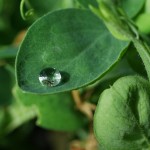
We are extremely busy this time of year, between all the green fairs and festivals, plus our workshops. Many weekends are surrendered to the cause of green living, reducing ones carbon footprint by installing a rain barrel.
After visiting California recently I started to realize that based on climate and water usage you may not need a rain barrel. Then I thought, well what would it hurt to have one anyone. And all I could come up with is that it couldn’t. There is almost no reason in my mind as to why you wouldn’t benefit from saving even just one barrel of water when you can save up enough rain. Then this all got me thinking about the many various uses for the extra water. Contrary to the many skeptics, rain barrels can be useful no matter who you are. The water can be used for many different uses, some of them are:
- Washing your car
- Washing your hair
- Watering House Plants
- Watering Outdoor Plants / Flowers
- Watering your lawn (using a Rain Barrel Pump)
- Reduce Stormwater Runoff
- Promote Rain Gardens and/or Ponds
- Washing the dog?
Let us know what you use your rain barrel for, leave us a comment below or Tweet us @MaxiContainer
***Under no circumstances do we recommend drinking rain water from your rain barrel. You don’t know whats on your roof… but Water Treatment tabs are handy to have and cheap… here’s a few on Amazon.com – keep them around in case of emergency, to turn your rain water into a drinkable source of water.
Tags: California, climate, Green, Green LIving, Michigan, rain barrels, Rain Water, summer
Posted in Blog, Latest News | No Comments »
Thursday, June 7th, 2012
My wife Gail and I decided to take a week off in Northern Michigan, enjoying the natural beauty and visiting the numerous wineries (some of which work with our sister company, miwinebarrel). We checked into The Inn at Torch Lake , a wonderful Bed and Breakfast in Alden, MI. While walking through town we came across the Spencer Creek Rain Garden.
Rain Gardens are nothing new to Maxi Container and mirainbarrel. As part of working with the Sierra Club Great Lakes Program we have learned quite a bit about rain gardens as a way, combined with our rain barrels of reducing storm water runoff into our streams, rivers and lakes. How surprised I was to see one, along a busy road, next to a bar, in Alden, MI. But, like many things, there is a story here.
As Priscilla Miller mentions in her article “The issue of storm water runoff from the roadway into the creek which flows into Torch Lake had been a concern of the Water Quality Protection Project for some time.” After a grant was acquired from the DEQ, the Alden State Bank, the Alden Bar & Grill, Bruce’s Excavating & Landscaping and the Alden Volunteers partnered with the Antrim Conservation District to build the Spencer Creek Rain Garden.
pThe Rain Garden reduces pollution of lakes and streams by using native plants to capture storm water and slowly filter into the ground so that it does not drain directly into the creek.
Here are some pictures of the completed Spencer Creek Rain Garden.
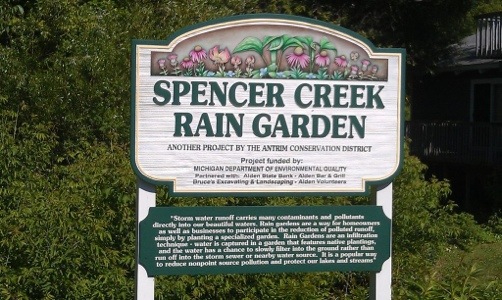
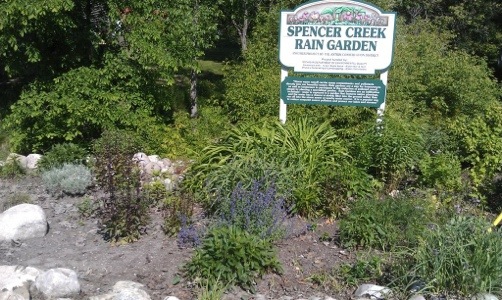
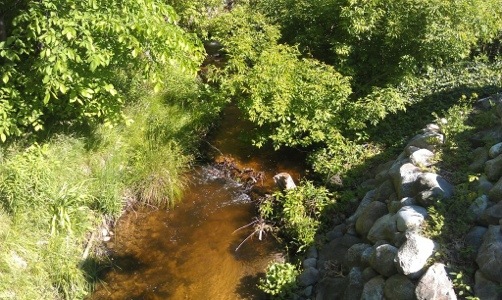
For more information on Rain Gardens please feel to contact Joshua@mirainbarrel.com or download the rain garden guide from the Sierra Club Great Lakes Program Sierra Club Rain Garden Guide.
Tags: Michigan, wine
Posted in Blog, Latest News | No Comments »
Monday, May 21st, 2012
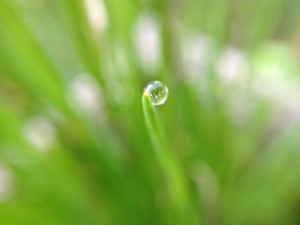
It is funny how things work. You always hear the saying that “a journey of a thousand miles begins with a single step”. Or, in the environmental field that “one person can make a difference”. We nod our heads agreeing, but then we go on like before.
Here at Maxi Container and our sister site, mirainbarrel, we have decided that we are going to make a difference, one rain barrel at a time. There are so many reason why using a rain barrel to harvest rain water makes sense. The water is better for your garden, you help reduce pollution and storm water run off, you save money, etc.
But one thing leads to another. Last month we hosted the first Rain Barrels on the River Front with the Sierra Club Great Lakes Program and the Detroit Riverfront Conservancy. One of the attendees was Claire M. Galed. As it happens Claire is the Manager of the Huntington Woods, MI Department of Public Works. She contacted us and now, Maxi is teaming up with Huntington Woods to sponsor a rain barrel workshop for all Huntington Woods residents on July 22, 2012.
We are very excited to be working with Claire and Huntington Woods. Clearly, here is one person who is making a difference.
Download the flyer here
Sign up for the Huntington Woods workshop or any of our workshops at mirainbarrel.com/signup
Tags: Detroit Riverfront, events, Huntington Woods, rain barrels, Workshops
Posted in Blog, Latest News | No Comments »
Friday, May 18th, 2012
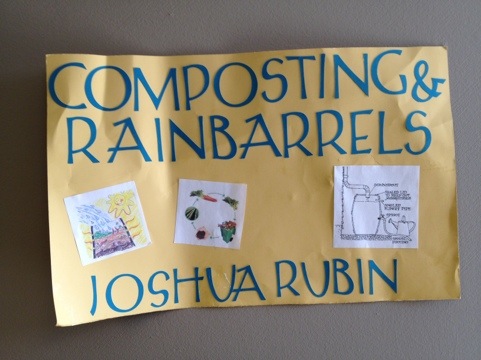
Recently I got the opportunity to be a special guest speaker at Johnson upper elementary thanks to Julie Thompson, leader of their PTA. One of my favorite things to do is talk to kids about water conservation, reuse, composting etc. The questions they ask are priceless and I also make sure to ask them a lot of questions too. In my day to day I forget sometimes what it was like in middle school. When your attend school dances and feel awkward and actually I “rebeled” as my parents would say, refusing to join any school teams but rather spend all my hours after (and sometimes during) school skateboarding. I still skateboard and it has given me a perspective that I would not otherwise know. When I arrive at the skatepark you have kids of all ages interacting it’s their park. Like it’s their park… This is our earth and we all have to take care of it. If we don’t teach kids the importance of green living then it will surely die. In a throw away society, water that just magically flows out the tap, soil which you buy at a store are winning. It’s time to change that, and change starts with the kids.
Tags: Composting, Green, Green LIving, rain barrels, schools, Water Conservation
Posted in Blog, Latest News | No Comments »
Monday, May 14th, 2012
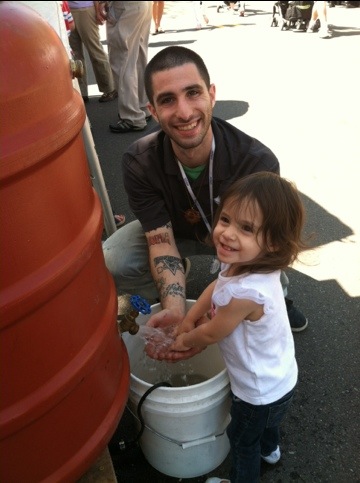
Boy, have we been busy. Rain Barrel Season started early and the response has been overwhelming. On April 14, 2012 we partnered with the Sierra Club Great Lakes Program and the Detroit Riverfront Conservancy to host Rain Barrels on the Riverfront. Over 100 participants used Maxi Container’s Rain Barrel Kits to build their own Rain Barrels.
A week later, April 21 and 22, we were at the Grosse Pointe Live Green Fair, were our own Joshua Rubin was interviewed on Fox 2 News about our rain barrels. After the interview, people were waiting at our booth to purchase our repurposed rain barrels.
Upcoming events include, Chelsea Live Green Fair, May 19 and 20, Rochester Green Living Festival, June 22, 23, and 24, Wyandotte Green Live Fair, July 11, 12, 13, and 14, The Lavender Festival, July 13, 14 and 15 and the Farmington Founders Festival July 20 and 21, 2012.
April 28, 2012 found us at St. Paul’s Presbyterian Church in Livonia hosting a Rain Barrel workshop. Part of the proceeds were used to benefit St. Paul’s community outreach garden initiative to “Feed the Hungry.” Over 20 people participated and went home with their Rain Barrel helping to raise money for their community garden and to help protect the Great lakes by reducing pollution caused by Storm Water run-off.
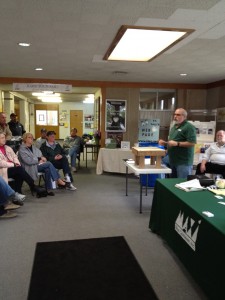
Rick talks to the attendees at St. Paul's Rain Barrel Workshop!
May 4, 5, and 6th found us at the Plymouth Green Street Fair. This is usually one of the better green events and this year’s did not disappoint. After gloomy weather on Friday, Saturday and Sunday were bright and sunny, bringing thousand of people to Downtown Plymouth. In the past two years, we sold out of rain barrels at the Plymouth Green Street Fair, so we made sure to have extras. Interestingly, while we sold more rain barrels then in years past, it was our compost tumbler that sold out. Another big hit was our rain barrel stands made from wood reclaimed from used wooden pallets. We also introduced RainSaucers and our up-cycled steel drum benches.
We had a wonderful time at all of these events interacting with people interested in rain water harvesting and protecting our environment. If you have an event our are interested in setting up a fundraiser for your non-profit group, feel fee to give us a call at 1-800-727-MAXI or contact me at rick@maxicontainer.com.
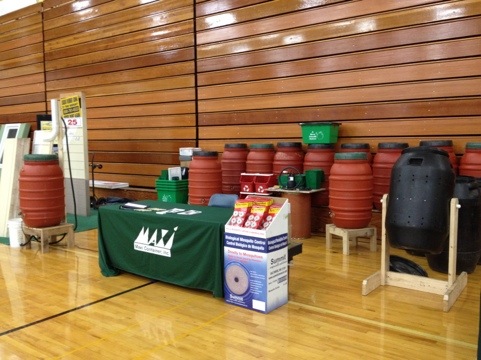
Our setup at Grosse Pointe Live Green Home Show

I had a great time on my birthday at the Plymouth Green Street Fair

Our RainSaucer Garden
Tags: events, Green, Green Fairs, grosse pointe, Plymouth, rain barrels, RainSaucers
Posted in Blog, Latest News | No Comments »
Sunday, April 22nd, 2012
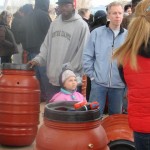
Last Saturday, April 14, 2012, The Sierra Club Great Lakes Program, The Detroit Riverfront Conservancy and Maxi Container, Inc. teamed up to hold the first ever Rain Barrels on the Riverfront, a free workshop and rain barrel sale. At the event, participants learned how to make their own rain barrels out of used food grade plastic drums. They also learned how to disconnect their downspouts to connect the rain barrels.
It was a great success with over 80 rain barrels made by the workshop participants. Based on a formula developed for an earlier post, those 80 rain barrels, based on last years 47.7 inches of rainfall in metro Detroit and the average size of roofs in the United States, could prevent 384,000 gallons of water from entering the areas sewers each year. This in turn helps to prevent raw sewage overflows into the Detroit River.
Based on its success we are already planing next years Rain Barrels on the Riverfront. Stay tuned for more information as it develops. To see photos from Rain Barrels on the Riverfront click here.
Event Partners:
Sierra Club Great Lakes Program
The Detroit Riverfront Conservancy
MI Rain Barrel (aka Maxi Container)
If you would like to setup a rain barrel workshop for your non-profit, school, religious institution, city/township or any other organization please contact us at info@mirainbarrel.com and let us know. MI Rain Barrel is a division of Maxi Container solely dedicated and focused to improving your home and garden. Learn more at mirainbarrel.com
Posted in Blog, Latest News | No Comments »
Thursday, April 5th, 2012

If you have not already noticed our involvement in the Great Lakes program hosted by the Sierra Club (America’s oldest grassroots organization). We have partnered again for a kick-off spring event on the Detroit Riverfront. This is a three-way collaboration between the Sierra Club, The Detroit RiverFront Conservancy and Maxi Container, Inc. This event is free to the public to watch learn and listen as we build barrels and show how to attach them to a downspout on your home. You can also pickup a barrel for $60 or per-register to receive the discount and build your barrel with us! (visit: http://mirainbarrel.com/signup and click on “Rain Barrels on the Riverfront” to sign up now!) This event is going to be a fun Saturday morning (April, 14th) … bring the whole family!
For more info please call 313-444-3705 or visit http://mirainbarrel.com
Download the official Flyer here
We kindly urge you to share this event with your friends and colleagues!
ANNOUNCEMENT:
Detroit City Councilman Kenneth Cockrel, Jr. and U.S. Representative Clarke plan to attend and give remarks at the beginning of the workshop/sale.
Contact Joshua at info@mirainbarrel.com for more information on this workshop.
Tags: Detroit, rain barrels, RiverFront, Water
Posted in Blog, Latest News | 2 Comments »
Friday, March 30th, 2012

U of M Art School student Diane Thach with donated steel Drum
Maxi Container was recently contacted by U of M School of Art and Design student Diane Thach. In August 2012 she will be one of 10 U of M students traveling with U of M School of Art and Design Detroit Connections Co-ordinator Charlie Michaels to Nungua, Ghana. Once there they will be teaching young adults how to make charcoal out of sugarcane and other natural agricultural waste.
This program has several goals. Ghana has one of the highest rates of deforestation, losing 2.19 percent of its forests per year. According to one study, forest biomass removal for fuelwood and charcoal represents the major source of energy for over 75% of Ghana’s population. Furthermore, traditional wood based charcoal smoke has a variety of irritant pollutants, some of which are known carcinogens. More than 1.5 million deaths a yearare caused by acute respiratory infections from breathing smoke from indoor cooking fires. Finally, wood charcoal is expensive. Poor families in Ghana can spend over 25% of their income on fuel.
The charcoal produced from the sugarcane and agricultural waste burns cleanly, reducing exposure to the smoke that causes respiratory infections; it uses agricultural waste materials, and therefore does not contribute to deforestation; and it transforms a waste stream into a high-value, income generating product.
Under the model developed by MIT’s d-lab a 55 gallon steel drum is an integral part of the charcoal making process. It is the kiln in which the agricultural waste is carbonized to begin the charcoal making process. Maxi Container, donated a used food grade steel drum for the students to practice prior to their trip to Ghana.
According to Charlie Michaels, they will be keeping a blog while on their trip in August. Stay tuned for future updates on this exciting program.
Tags: Art, Bio-mass, College, design, energy, Ghana, schools, U of M
Posted in Blog, Latest News | No Comments »
Saturday, March 24th, 2012
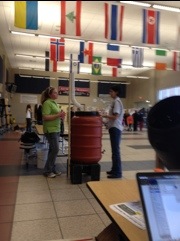
Last night, Anchor Bay Middle School hosted a green Science Night, and were invited to show our rain barrel and compost tumbler. When I arrived ( a little late ) the hallways where filled with kids from 6th, 7th, and 8th – quickly setup and started to engage in conversations with students and parents.
My colleague, Annette was also there to help explain the many benefits of rain water harvesting. Many had questions and we handed out flyers for our upcoming free event “Rain Barrels on the Riverfront” hosted by the Detroit RiverFront Conservancy and The Sierra Club. ( Download the flyer )
After about two hours the crowds slowed and we began to pack up, before I left they started the raffle. We donated a Rain Barrel to be raffled off, here is a pic. (I’m not sure who won it still though)
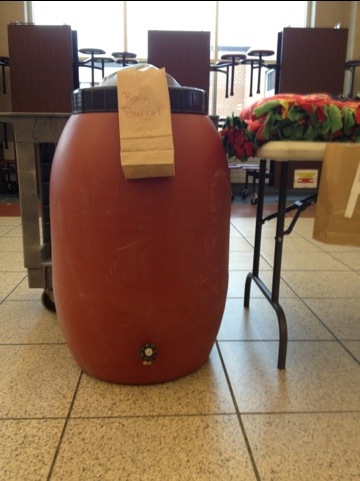
Overall, we had a wonderful evening and I would like to on behalf of Maxi formally thank Anchor Bay Middle School North for organizing the event and including us. Our friend from GreeningDetroit.com were there too… Checkout there website for more info and video from event here.
I also heard that yesterday Anchor Bay MS North received their official MI Green School Certification, congratulations!
If your school is having a green event like this please contact me at joshua@maxicontainer.com
Tags: Compost, Education, Green, Rain Barrel, schools
Posted in Blog, Latest News | No Comments »
Friday, March 9th, 2012
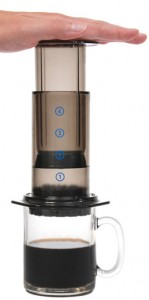
The AeroPress
My wife Gail and I are self proclaimed coffee snobs. We like our coffee strong, robust and fresh. We have been buying whole bean coffee and grinding our own beans since 1978, and have had every kind of coffee brewer, espresso maker and French Press you can imagine. My wife and I are now empty nesters. Our son Joshua is married with a family of his own. Our daughter Michelle is away at college. We no longer need to make a full pot of coffee every morning. But, we are strong believers in sustainability and recycling so we will never ever buy one of the fancy expensive single cup coffee makers that are so popular.
These one cup coffee machine, such as the Keurig and Tassimo, seem to have become ubiquitous. I see their little “k-cups” and coffee pods everywhere. Although expensive, many people have opted for the convenience offered by these single serving coffee systems. According to the Los Angeles Times, in the 12 months ending in November, nearly 46% of the dollars going toward the purchase of coffee or espresso makers went to single-serve machines. The L.A. times story reports that according to Keurig 13% of all US offices has one of their machines.
The problem with this is that single servings of anything, by definition, have more packaging and create more waste than buying the same product in bulk. In this case, the environmental impact is complicated by the difficulty in recycling the single serving k-cups and pods. Tim Wall at Discovery News points out that the k-cups are made of a plastic shell, lined with a paper filter and topped with aluminum. Individually, the components are recyclable, but put together they can only be trashed. What’s more, the compostable coffee grounds are trapped inside.
So how to make a single or double cup of really good coffee while staying true to our core values? The answer turned out to be a $30 little plastic coffee maker called the AeroPress. I had kept coming across references to it in different blogs but couldn’t find it in any local store. The reviews were simply amazing. As explained by Mike Crimmins in his Daily Shot of Coffee Blog, the Aeropress came from inventor Alan Adler, who is best known for his Aerobie flying ring and similar toys. He took a scientific approach to making coffee and came up with the Aeropress.
The Aeropress is a simple machine. According to Gizmag the AeroPress delivers the smoothest, richest, purest and fastest cup of coffee (under 30 seconds) you’re likely to find. The AeroPress can make up to four cups of great coffee at a time, much faster than my espresso machine or a single cup system. I have to agree and best of all, the only consumables used are the coffee grounds and the small paper filter, both of which are compostable.
Tags: Coffee, Green, Green LIving, Packaging, sustainable, waste
Posted in Blog, Latest News | No Comments »
Wednesday, March 7th, 2012
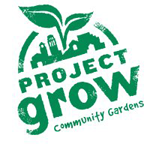
Last month, on April 25th, Project Grow and Maxi Container partnered for a very successful Rain Barrel workshop. Project Grow is a nonprofit community garden in Ann Arbor. Joshua (Me) and Lucas (PG) planned the workshop during February. We had such a tremendous response that we needed a bigger room! I arrived to meet Lucas and a couple of happy to help volunteers. After unloading the barrels, people started to show up. I was amazed at the demographic, we had family’s with little ones and senior citizens, plus tons of young adults eager to build a rain barrel and Go Green! (Oops, I guess Go Blue! is more appropriate in A2.)
After the check-in and setup I demonstrated how to build a barrel and did a little lecture and opened the floor for questions. I really was amazed at how prepared the attendees were, full of good and important questions and eager to build. Quickly wrapped up the introduction session and broke out into small groups to build.
The building process went smoothly, as the entire workshop did and most importantly…
41 Rain Barrels found new homes.
If you don’t know about our Maxi Rain Barrel, they are previously used food grade barrels that otherwise don’t have much use… either slated to be land filled or turned into regrind (recycled) which used up fossil fuels. Turning these “pickle” barrels into Rain Barrels truly reduces your carbon footprint while extended the plastic barrels life cycle, help preserving our Great Lakes at the same time. Truly there is no better way (and simple) way to go green then installing a rain barrel.
Please check out all of the photos from the workshop below in a slideshow, or you can view them here on our Flickr.
[slickr-flickr search=sets set=72157629103265414 type=slideshow attribution=©RebeccaSunde]
Interested in taking part in one of our Ann Arbor Rain Barrel Workshops with Project Grow?
Sign up to get updates on upcoming workshops!
Tags: Ann Arbor, Community Garden, Michigan, Project Grow, Rain Barrel, rain barrels, Workshop
Posted in Blog, Latest News | 2 Comments »
Thursday, March 1st, 2012

I have written in the past about my views on bottled water and the movement to ban it on several college campuses. Recently, Charles Fishman, an award winning investigative journalist and author of The Big Thirst posted a blog on National Geographic website that while pointing out the numerous problems and environmental impacts of bottled water went on to argue that:
“Banning bottled water doesn’t really teach anyone anything.”
His argument, which makes a lot of sense, is that banning bottled water sales on campus, while allowing the sale of soda and energy drinks is illogical. He points out that these products are 95% to 99% water and that, “It takes 2.5 liters of water to produce every liter of Coke products”.
Fishman points out the negative environmental impacts of bottled water, stating that “It takes a fleet equivalent to 40,000 18-wheelers just to deliver the bottled water Americans buy every week”. However, he questions whether this is any different than the fleets delivering caramel-colored, caffienated water in bottles?
Fishman is no stranger to the negative impacts of bottled water. I highly recommend his 2007 article, Message in a Bottle which explores the bottled water phenomenon in depth. In that article he determines that:
“Buying bottled water is a choice … and given the impact it has, the easy substitutes, and the thoughtless spending involved, it’s fair to ask whether it’s always a good choice.”
In my opinion, that question has been answered over and over. Due to its negative environmental impacts, bottled water is only a good choice where there is not access to safe reliable tap water. On most college campuses in the U.S. safe drinking water is readily available, as are reusable bottles.
USA Today states that according to the Association for the Advancement of Sustainability in Higher Education (AASHE), 14 colleges and universities in the United States and Canada have campus-wide bans, while another dozen or so have bans that cover a portion of campus. While these bans are a step in the right direction by creating awareness of the negative impacts of bottled water, by not addressing the environmental and health impacts of the remaining beverages, including soda and energy drinks, they fall far short of promoting an overall sustainable college environment.
However, recently the University of Vermont became one of the first universities in the U.S. to not only ban the sale of bottled water but to mandate that one-third of the beverages in its campus vending machines be healthy options. The policy also has the University changing its drinking fountains into bottle refilling stations so that students can use refillable bottles instead of using, and disposing, of plastic water bottles.
Wisebread.com has listed 22 reasons to stop drinking soda – Here are a few of my favorites:
- It may lead to diabetes and heart disease.
- Soda consumption is linked to osteoporosis.
- Drinking cola can increase your risk of kidney stones.
- It can take up to 132 gallons of water to produce a 2-liter bottle of soda.
- Be it glass, aluminum, or plastic, all bottles have their environmental costs.
- Transportation of soda pop requires a lot of fuel.
Sustainability has social, environmental and economic dimensions. Given the health and environmental impacts that soda has, the fact that the United States, with less than 5 percent of the world’s population, is the largest soda consumer and accounted for one third of total soda consumption in 1999, suggests that Fishman is correct that only banning water bottles on campus is not enough. To truly address the societal and environmental costs, our colleges and universities should, as did the University of Vermont, require the availability in vending machines, in dorms, food service on campus, healthier alternatives to soda.
Here is a very interesting infographic about why you should not drink bottled water …

Let me know what you think about bottled water and soda issues on campuses around the country, please leave a comment below!
Tags: Bottled Water, Campus, College, Green, sustainability, University, Water
Posted in Blog, Latest News | No Comments »
Monday, February 6th, 2012
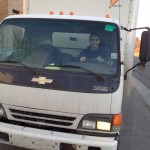
Tis the season! [enter applause]
We’ll you may be thinking, “what season” or “aren’t the holiday’s over?”.
Yes! You are correct but the Green Season is just about to begin.
Maxi Container hasn’t just begun a transformation into a green enterprise, we are only embracing our most honored values and traditions and giving back to mother earth by selling our Terra Cotta Rain Barrel Kits. The product itself isn’t new but the attitude and determination as well as honest price and great results make our barrel better. It’s not the fanciest, it’s not the sleekest but it’s the best you will find for $60.
Trying to make your own barrel, that’s cool ask us for advice. We have plenty of barrels of all different colors, shapes, and sizes perfect for rain water collection. Please don’t just use a Rubbermaid garbage can made from low density polyethylene, that will eventually crack and bow when full. Don’t use a barrel you got for free from the car wash or any anonymous source. Get it from the barrel experts over at Maxi. We guarantee you get a previously used food grade barrel each and every time, it’s our profession and we take it to heart.
Preventing storm water runoff is only the begining, soon you will see our Rain Barrels everywhere ($40 shipping anywhere in the U.S.) but that’s not all… we teach workshops and make our weekends our work and go around Michigan’s best Green events too… lookout for a calendar widget on the sidebar coming soon.
For now I will leave you with this, a slide show of last years all star Maxi “Green Team” at our Rain Barrel events, enjoy!
View all of our photos from last years Green Events here.
Tags: 2012, events, Green, Green Fairs, Green LIving
Posted in Blog, Latest News | No Comments »
Monday, February 6th, 2012
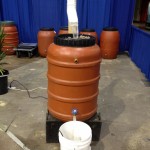
It hard to imagine in February that Spring, and our Rain Barrel Season, is right around the corner. We will be teaming up with the Sierra Club’s Great Lakes Program again this year to promote the use of rain barrels to help reduce Detroit’s combined sewage overflows and storm water pollution. This past weekend we had our first Live Green Fair of the season at Kellogg Arena in Battle Creek.
Last year, we sold 440 rain barrels and hope to better that mark this year. When talking to people about their rain barrels we tell them how quickly they will fill up in a good rain. In talking with Melissa Damaschke of Sierra Club’s Great Lakes Program we decided to attempt quantify the amount of rain water those 440 rain barrels could harvest in a year.
Being that I love researching an issue and spreadsheets, I immediately volunteered. Here is what I found.
The average rainfall in Detroit, MI is 32.89 inches. As reported in many news sources, 2011 was the wettest year in Detroit’s history with 47.7 inches of rainfall. (Climate Change anyone?) The average roof in the U.S. is 2400 square feet. To figure out how many gallons of water you can collect off your roof, just multiply the square footage of roof space by 0.6 gallons per square foot per inch of rain.
Plugging in this formula to the average yearly rainfall we get (2400 sq ft x .06) x 32.89 or 47,361.6 feet of space per house. Multiply this by our 440 rain barrels and in an average year we could help keep 20,839,104 gallons of water out of the storm sewers. Substituting the actual rainfall from 2011 of 47.7 inches and you get a total of 30,222,720 gallons of water saved.
Obviously, this example is based on every rain barrel we sold collecting every drop of rain from every home. In the real world, most people only hook the rain barrel up to one downspout. But even if only 1/4 of the rainwater was collected, that is over 7.5 million gallons of rain that we helped to collect for people to water their gardens, cars, etc. That is over 7.5 million gallons of rain water that did not make it’s way into the Detroit combined sewer system, did not help push raw sewage into the Detroit River and did not help cause one of the worst algae blooms in Lake Erie’s history.
It really is amazing how much good you can do with a simple thing like one of our Terra Cotta Rain Barrels.
Tags: conservation, Green, Rain Barrel, Water
Posted in Blog, Latest News | No Comments »
Wednesday, February 1st, 2012

One of the perks of owning your own business is that you can take time to be involved in your community. Today, I was involved in an event that proved the old saying, “Think globally, act locally.” Thanks to John Carlos and our friends at GreeningDetroit.com my son and co-worker Josh Rubin and I were Judges at the 2012 Michigan Regional Future City Competition hosted by The Engineering Society of Detroit (ESD). We helped determine the winner for a “special award” for the “Greenest City”. (Sponsored by GreeningDetroit.com)
The Future City Competition challenges students to design a city of the future and have fun doing it. The program is designed to promote technological literacy and engineering to sixth, seventh and eighth grade students. The idea is to foster an interest in math, science and engineering through hands-on, real world applications and help students better understand the practical applications of mathematical and scientific principles.
I met 6th, 7th and 8th graders from many different types of schools, from city schools to charter schools, and church schools to public schools. It was a very diverse group kids from all over the state. They all had one thing in common, enthusiasm. They spoke to myriad adults from many large and small business explaining in detail their model city. All of the designs were imaginative and addressed issues that we are all familiar with. Some had communication services that alerted paramedics in the event of a medical emergency. Others used maglev transportation systems, vertical farms, bio-domes, passive solar heating and living roofs among the many technologies. The students addressed where people would live, where they would work and how they would get there.
Our team of judges were looking for use of green products in building, sustainable development, greenery (parks and farms), how the city dealt with peak energy demands and the use of renewable energy. It was very difficult to determine the “Greenest City”, but after much discussion we gave our award to Birney K-8 School, Southfield, MI.
Birney’s entry had a recycling center, vertical farming, green roofs, geothermal, solar and piezoelectric energy. They used anaerobic digestion to break down wastes, recycled gray water, composted their food waste and, most dear to us at Maxi Container, used rain barrels to harvest rain water for irrigation.
As impressive as the students at Birney were, I was also impressed by St. Valantine’s who had movable sidewalks and a desalination plant. Hazel Park’s used electrochromic glass to control the light and heat in their buildings. Academy of the Sacred Heart used a combination of solar, wind and tidal power. The underwater turbines were bladeless so as not to harm sea life.
You can see a complete list of the winners here, but if you ask me, all of the schools were winners and so was our community as a whole.
Here is a slideshow from the event.[slickr-flickr search=sets type=galleria set=72157629134157333]
Tags: City, engineering, Green, schools
Posted in Blog, Latest News | No Comments »
Wednesday, January 11th, 2012
Continued from our Jan. 2012 eNewsletter.

Recently we invested in energy efficient lighting for our warehouse. Our new induction lighting provided by the Eco-Green-Energy. It uses half the energy as before, making it more cost effective and better choice for the environment.
One of the things I noticed when we purchased our new warehouse was the metal halide lighting in the warehouse. There were sixty 400 watt fixtures in the warehouse and while they offered plenty of light there were several problems with them.
1. Metal halide lights do not turn on right away. The warm up period can be as long as five minutes. In a warehouse full of pallets and drums, this means that you have to wait before you can walk around.
2.They are expensive to operate. On average a 400 watt metal halide costs $130.13 per year to operate. With 60 of them the average cost would be $7807.80. In our case, because of the number of hours we work, it was estimated that our cost would be $10,672.10 per year.
We turned to Sheldon Wardwell of Eco-Green. They proposed replacing the 60 400 W Metal Halide lights with 200 watt High Bay Induction lights. By using one-half the energy, we would cut that yearly cost in half, also reducing the CO2 and carbon emissions associated with electricity production. The new lights also have no warm up time and should last up to 100,000 hours.
The icing on the cake was that our local electric utility, DTE, had a Your Energy Savings Program that provided rebates to us that cut the cost of installation by 30%. This reduced our payback period for this project to only 2 years.
Next up, changing our office lighting from fluorescent to LED. The future is certainly looking bright.
Tags: DTE, Eco-Green-Energy, energy, fluorescent, Green, induction lighting, LED, Lighting, metal halide, metal halide lighting, Technology
Posted in Blog, Latest News | No Comments »
Thursday, January 5th, 2012
Here is a very interesting info-graphic which illustrates the new and volatile landscape that is high-tech corporate patent wars… Take a closer look, let me know what you think.

Via: Business Insurance Site
As a Creative Director, I use a lot of these patented devices and software, it is interesting to see how aggressive the patent war has become. I think that the future will prove to be clouded by these types of litigation and hopefully doesn’t slow innovation at the same time. As high-tech products make their way into the business world, increasing productivity and allowing employers to stay connected with their staff in many new ways, the changing landscape could become volatile. Let’s hope not.
Digital devices are not only leading to increase in productivity for many but also reducing the paper trail, traditionally associated with business which is a way to “Go Green” … every little bit counts!
Tags: Apple, device, Google, Green, HTC, IBM, law, Microsoft, Patent, patents, software, Tech, Technology, US
Posted in Blog, Latest News | No Comments »
Monday, January 2nd, 2012
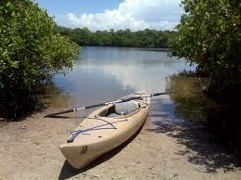
In past posts I have mentioned several of my favorite places. Another of my favorite places is Sarasota, Fl. I lived there in my late twenties and early thirties, and have vacationed there almost every year since we moved to Boston and then Michigan. Recently, the beach on Siesta Key (where I lived for a year) was rated the best beach in the US by Dr. Beach who is really coastal expert Dr. Stephen P. Leatherman, Director of Florida International University’s Laboratory for Coastal Research.
This year we decided to do something different than just sitting on the beach or pool enjoying the warm weather. My daughter Michelle and I decided to take an environmentally oriented kayak tour of Sarasota Bay through Biotica EcoTours. Biotica EcoTours stresses the environmental and natural features of this important estuary.
Estuaries occur in areas where freshwater meets and mixes with salty ocean waters. The Florida Department of Environmental Protection call estuaries “The cradle of the ocean” because more than 70 percent of Florida’s recreationally and commercially important fishes, crustaceans, and shellfish spend part of their lives in estuaries, usually when they are young. The shallow water, salt marshes, seagrasses, and mangrove roots provide excellent hiding places from larger, open-water predators.
Estuaries are among the most productive ecosystems in nature. Rivers and streams drain into estuaries, bringing in nutrients from uplands. Plants use these nutrients, along with the sun’s energy, carbon dioxide, and water, to manufacture food. Florida’s estuaries, including Sarasota Bay, have been significantly degraded by development. Some of the most expensive real estate on Bird Key, Lido Beach, Longboat Key, Siesta Key and along Sarasota Bay, used to be covered with Mangove trees and sea grasses, before the dredge and fill development of the 1950’s to the 1970’s.
Here is a picture of Bird Key as it was.

Here is a picture of Bird Key today.

During our kayaking trip, we saw the rusted hulks of the original dredging equipment.
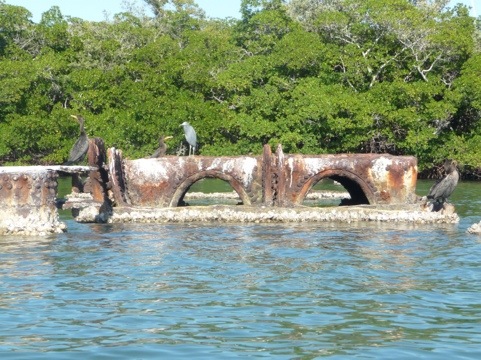
Interesting it has become a nesting place for numerous birds and a place where coral and oysters live.
During our tour we saw all three types of Mangroves, Red, White and Black. We saw numerous bird species including the Double Breasted Cormorant, Great Egret, Great Heron and Osprey. We even saw a young Bonnethead shark that appeared to be injured. One of the most fascinating part of the tour was going through the tunnels that were made through the Mangroves in the 1950’s in a misguided and ill-advised attempt to reduce the mosquito population. In the tunnels we saw coral, oysters and mud crabs, among others. Here is a picture of the mangrove tunnel as our tour leader, Christine navigates her way in. (photo by Michelle Rubin)
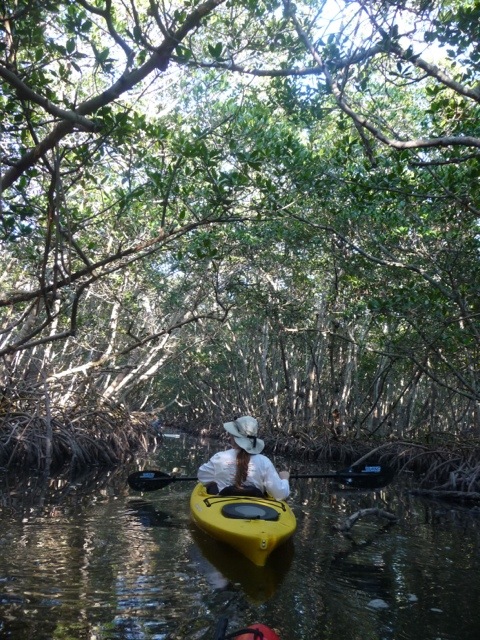
In all it was a wonderful, educational and exciting way to spend an afternoon. I highly recommend Biotica EcoTours and our guide Christine, who selflessly rescued me when I tipped my kayak and ended up in the refreshing and clean waters of Sarasota Bay. Here are some final pictures of Christine, my daughter Michelle and me kayaking Sarasota Bay.
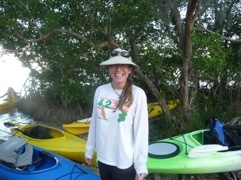

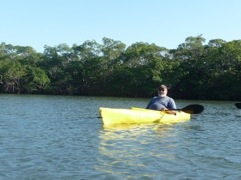
Tags: beach, beaches, Bioteca, Biotica EcoTours, Bird Key, birds, dredging, eco-system, ecosystem, ecosystems, EcoTour, EcoTours, estuary, Florida, Kayak, Kayaking, Lido Beach, Longboat Key, mangove, mangove tunnel, mangove's, Nature, oysters, recreation, Sarasota, Sarasota Bay, Siesta Key, wildlife
Posted in Blog, Latest News | 2 Comments »
Tuesday, December 27th, 2011
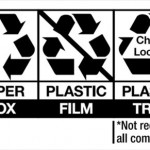
Over the past decade a lot has changed in the recycling world, new products such as bio-plastics have made their way into the recycling stream. The original “No. 7” group for non-recyclables is now too large to contain the new materials on the market. A complete redesign for the labeling of recyclable material is too important to ignore anymore. A pilot program was put together by the Package Recovery Label System, rolling out sometime 2012 hopefully. The program included five companies such as Microsoft and REI.
“Consumers are faced with a confusing landscape of recycle messages…” Anne Bedarf, the Project Manager of the test labeling project. Bedarf hopes to prove the effectiveness of the new labels which in turn will increase recycling rates in many communities.
The new labels will classify packaging of products into three categories:
- widely recyclable
- not yet recyclable
- not recyclable
For material with limited recycling the phrase “check locally” will be in the center of the chasing-arrows icon. For non-recyclable material a black diagonal line will cross through the arrows.
This pilot-program is the beginning of change, the beginning of more accurate way to sort recyclable material found in consumer packaging as well as an attempt to change the way we think about whether something can or cannot be recycled. Hopefully, it will lead to more material making it to the recycling bin rather than the trashcan.
There are still bumps along the road ahead, recyclable material may become easier to identify but that doesn’t necessarily mean it will be easy to actually recycle it. Hopefully this over-haul of the recycling labels will encourage more communities to institute curbside-recycling or create more recycling centers or drop-off locations.
If you would like to learn more about this project, please read my other article about recycling labels.
Let me know what you think, leave a comment below…
Do you believe that new recycling labels will increase recycling rates?
Original article by Mike Verespej Waste and Recycling News – Nov 14, 2011.
Tags: curbside recycling, non-recyclables, Plastic, plastics, recyclables, Recycle, Recycling, recycling labels
Posted in Blog, Latest News | No Comments »
Thursday, December 8th, 2011
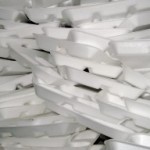
Styrofoam, just the sound of the word may send chills down the spines of many.
“Doesn’t that stuff NEVER break down?”
The answer is Yes. But there is more to the story. Styrofoam is actually Polystyrene aka Plastic, which has been infused by air to puff it up. We all know that air is a good insulator, so Styrofoam keeps your coffee warmer longer for this reason.
If you throw Styrofoam in the trash, then it will go to a landfill and will not break down for hundreds of years, maybe never! So what do we do about all of this foam waste?
Recycle it!
You got it! Styrofoam is actually very recyclable, but one of the least recycled materials because it is mostly air and therefore recyclers do not waste their time hauling it because the rates are too high.
Luckily, there are progressive companies like Dart Container in Mason, MI (outside Lansing) who have a polystyrene recycling facility and collect within a 100 square miles as well as accept deliveries of used Styrofoam. If you would like to learn more about Dart and their recycling initiative please read my article about it, which is based on a tour I took of their facility.
Recently, a life cycle analysis (LCA) was released by Cascades, Inc., which dispels many myths about the illustrious Styrofoam. The LCA demonstrates the vast capabilities of the material as well as calculating the ecological effects of its manufacture and use.
The study proves that polystyrene is actually a good choice for the environment, based on the fact that the impact of a material on the environment is determined by the type and amount of energy used to make it. Here’s what they found out:
- Produced least amount of greenhouse gases throughout its entire lifecycle from raw material extraction to end-of-life.
- Composed of 90 percent air.
- Recyclable, though rarely recycled.
- Using recycled polystyrene has tangible ecological benefits, using the recycled material results in less raw material extraction.
Designed to judge the environmental impact of Cascade’s food packaging trays, the LCA included 7 types of packaging materials.
- Foamed and oriented polystyrene (XPS and OPS) #6 Plastic.
- Standard and recycled polyethylene terephthalate (PET and RPET) #1 Plastic.
- Polylactic acid polymer (PLA) grouped with the #7 Plastic category.
- Polypropylene (PP) #5 Plastic.
- Molded pulp (made from recycled newspapers and telephone books).
The president of Cascades, Luc Langevin said:
“This analysis provides an new perspective on food packaging. The environmental performance of our trays is much better than popular belief. Polystyrene foam can now be part of our environmental packaging solution.”
“These findings have us taking stock of our current situation so that we can better understand our impact and thereby improve our efforts to reduce the environmental footprint left by our products.”
I hope that this post helps shed some light on the myth’s about Styrofoam. It is actually a very ecologically sound choice, thus why we use and recycle all of our Styrofoam cups here at Maxi. We hope that in the future, more companies and consumers start to understand the ecological benefits associated with choosing Styrofoam over paper cups. I urge you to please forward this post to someone whom you think would benefit from the information.
The full results of the LCA are available on cascades website.
Original article found though Packaging Diva published by JoAnne Hines.
You can read the original article by Cascade’s Inc. in The Sacramento Bee by following this link.
Tags: Cascade, Container, dart, greenhouse gases, LCA, life cycle analysis, Packaging, Plastic, polystyrene, Recycle, Recycling, styrofoam
Posted in Blog, Latest News | No Comments »
![]()




